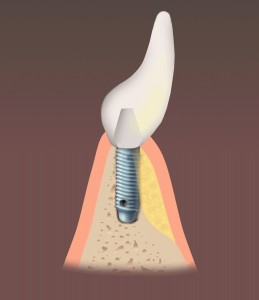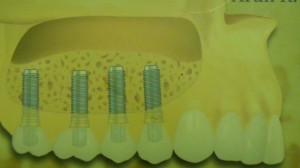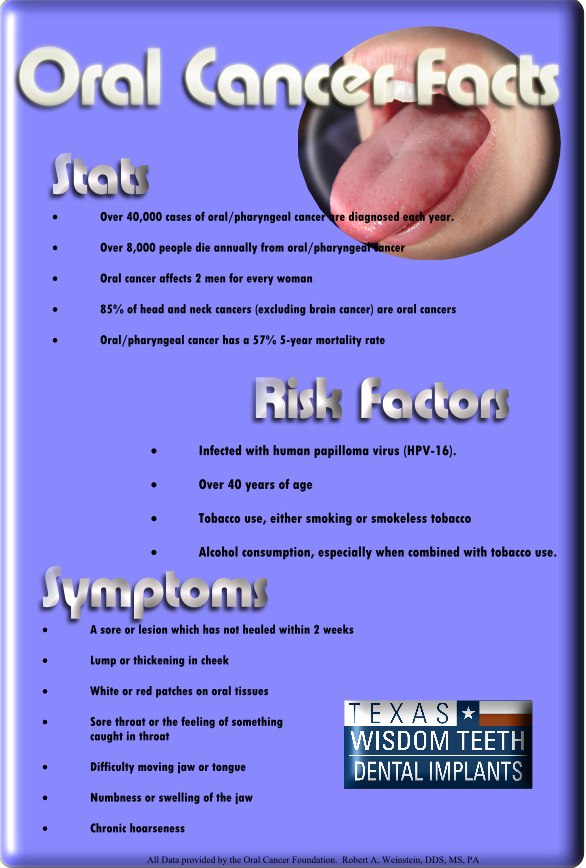Why You Should Not Dismiss Implant Dentistry As Too Expensive
 Unless you’ve been living on the Moon, you’ve probably heard the hype about dental implants for tooth replacement. The dental world has been proclaiming the glories and triumphs of multiple tooth replacement using implant dentistry for several years now. Just because everybody is talking about it now, doesn’t mean that implant dentistry is a new science. In fact, tooth replacement with dental implants has been a successful treatment option since the 1960’s. Even our ancient ancestors have dabbled in tooth replacement using pieces of ivory and shells, as far back as the Ancient Egyptians. What has changed in the practice of implant dentistry recently is that it has become a much more successful and financially accessible option for patients who desire to replace missing teeth.
Unless you’ve been living on the Moon, you’ve probably heard the hype about dental implants for tooth replacement. The dental world has been proclaiming the glories and triumphs of multiple tooth replacement using implant dentistry for several years now. Just because everybody is talking about it now, doesn’t mean that implant dentistry is a new science. In fact, tooth replacement with dental implants has been a successful treatment option since the 1960’s. Even our ancient ancestors have dabbled in tooth replacement using pieces of ivory and shells, as far back as the Ancient Egyptians. What has changed in the practice of implant dentistry recently is that it has become a much more successful and financially accessible option for patients who desire to replace missing teeth.
Teeth have a tendency to wear out, become decayed, infected and eventually lost. Even those of us with excellent oral hygiene will most likely lose a tooth at some point.
Missing teeth are an important concern for a number of reasons:
1) Missing teeth are unattractive
2) Missing teeth perpetuate bone loss in the jaw
3) Remaining teeth are stressed unnaturally in the absence of missing teeth, contributing to even more tooth loss
4) Missing teeth interfere with speech and the ability to chew our food.
For these reasons, dentists and dental professionals strive to educate their patients about their options regarding tooth replacement.
Dental Implants Vs. Bridge

Choosing the Best Option for You
A hot topic of debate among patients and dentists is centered on choosing the best option for tooth replacement. Dental implants have a long history of being a highly specialized, technologically engineered treatment option. In the recent past, dental implants have been a very expensive tooth replacement option. This is due to the fact that materials, hardware, planning and technique contribute to the cost of the procedure. Patients and dentists must weigh the options between dental implants vs. bridge or denture.
Here are a few facts to consider when deciding on a dental implant vs. bridge:
1) Dental Implants are the closest we have come to mimicking the anatomy and functionality of a natural tooth
2) Dental implants are ideal for patients who are missing teeth which are surrounded by undamaged or unrestored teeth. Replacing a tooth with a bridge requires that the adjacent teeth be ground down and crowned. While a reliable treatment option, the adjacent teeth are compromised and more susceptible to future damage.
3) Replacing a tooth with a dental implant is 97% successful over almost 50 years of research. A dental bridge will last 5-15 years before requiring replacement or extension due to damage and potential loss of the adjacent teeth.
4) Implant dentistry is one of the most reliable, predictable and effective options for tooth replacement, the gold standard in the dental profession.
What About The Cost of A Dental Implants Procedure?
Dental implant professionals have recognized that the high cost of dental implants can be a detractor for many patients. In recent years, the cost of materials and hardware has become less prohibitive. While dental implants do often cost more than a dental bridge, it is important to consider these facts when weighing your options:
1) Dental implants are a permanent solution for missing teeth, while a dental bridge or removable partial denture provides temporary solutions which must be replaced every 5-15 years.
2) Dental implants are now covered by a growing number of dental insurance companies
3) Many implant dentists have been able to control their costs and streamline their treatments to support a reduction in overall fees, making a dental implant more comparable in cost to a dental bridge.
4) Dental implants are more durable and stronger than other forms of prosthetics.
5) Dental implants help maintain important jaw bone structure and prevent excess bone loss in areas of missing teeth. Other forms of prosthetics cannot accomplish this.
Additionally, many implant providers are offering interest free financing and other financial options to help patients take advantage of the number one tooth replacement option available today. Dr. Robert Weinstein of Texas Wisdom Teeth and Dental Implants has heard the call to action by patients. Dr. Weinstein offers uncomplicated dental implants for a lower fee. For more information on low cost dental implants, click on the link.
For more information on dental implants, select one of these entries:
The History of Dental Implants
Advancements in Implant Dentistry


 height and width. Ideally, your dentist or oral surgeon will remove the damaged tooth and preserve the bone in the area using a simple bone grafting procedure. In this procedure, demineralized, sterile human bone granules, (which look like coarse sand), are packed into the tooth socket immediately after tooth extraction. The granules are covered with a protective collagen membrane and a couple stitches are used to close the tooth socket. This procedure is simple and usually does not add to your recovery time. Over the next several weeks, your own bone will fill the tooth socket and preserve the bone height long enough for you to have the area restored. If you replace the missing tooth with a dental implant, the bone level will remain indefinitely. If you replace the missing tooth with a bridge, you will lose some of the bone level over time.
height and width. Ideally, your dentist or oral surgeon will remove the damaged tooth and preserve the bone in the area using a simple bone grafting procedure. In this procedure, demineralized, sterile human bone granules, (which look like coarse sand), are packed into the tooth socket immediately after tooth extraction. The granules are covered with a protective collagen membrane and a couple stitches are used to close the tooth socket. This procedure is simple and usually does not add to your recovery time. Over the next several weeks, your own bone will fill the tooth socket and preserve the bone height long enough for you to have the area restored. If you replace the missing tooth with a dental implant, the bone level will remain indefinitely. If you replace the missing tooth with a bridge, you will lose some of the bone level over time.
